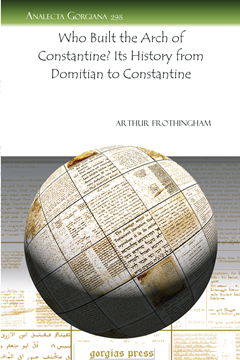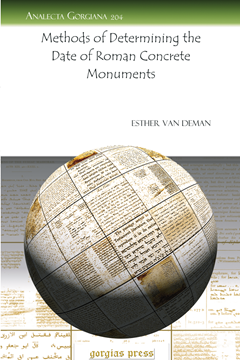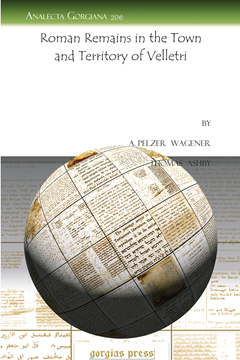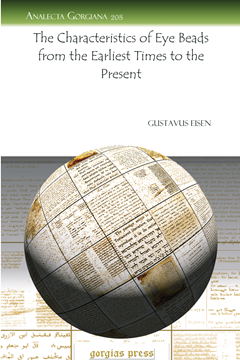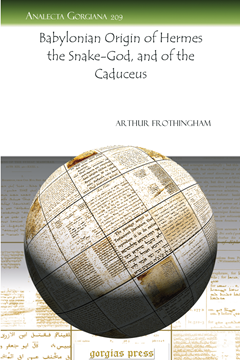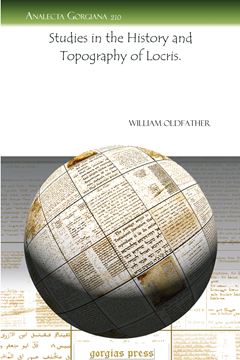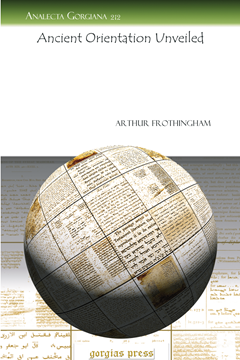Who Built the Arch of Constantine? Its History from Domitian to Constantine
Series: Analecta Gorgiana 298
ISBN: 978-1-60724-527-8
Arthur Frothingham, one of the founding fathers of Art History, here discusses the problem of the Arch of Constantine, whose form and artwork is at odds with the artwork of the era of Constantine.
$45.00 (USD) $27.00 (USD)
Methods of Determining the Date of Roman Concrete Monuments
Series: Analecta Gorgiana 204
ISBN: 978-1-60724-433-2
Esther van Deman, an important historian of architecture, shows the methodology by which building chronology was set for Roman concrete buildings,
$46.00 (USD) $27.60 (USD)
Attic Building Accounts
Series: Analecta Gorgiana 205
ISBN: 978-1-60724-434-9
William Dinsmoor, the famous historian of Greek architecture, presents the epigraphical evidence for this building process in this series of papers divided by individual building.
$58.00 (USD) $34.80 (USD)
Roman Remains in the Town and Territory of Velletri
Series: Analecta Gorgiana 206
ISBN: 978-1-60724-435-6
Wagener and Ashby here give a report on the Roman remains at the site of Velitrae including roads, temples, basilica, and the amphitheater.
$36.00 (USD) $21.60 (USD)
The Iconography of the Ascension
Series: Analecta Gorgiana 207
ISBN: 978-1-60724-436-3
Earnest DeWald traces the development of the iconography of the Ascension from its earliest type through to the Gothic form, showing the manner in which the Eastern influence modified the types current in western art.
$39.00 (USD) $23.40 (USD)
The Characteristics of Eye Beads from the Earliest Times to the Present
Series: Analecta Gorgiana 208
ISBN: 978-1-60724-437-0
In this ambitious article Eisen creates a chronology of eye beads (glass beads decorated with eye-like spots) from sites in Europe, the Near East, and North Africa.
$36.00 (USD) $21.60 (USD)
Babylonian Origin of Hermes the Snake-God, and of the Caduceus
Series: Analecta Gorgiana 209
ISBN: 978-1-60724-438-7
Arthur Frothingham, one of the founding fathers of Art History, here discusses the origins of Hermes, and suggests that the prototype of Hermes was an Eastern deity of Babylonian extraction.
$38.00 (USD) $22.80 (USD)
Studies in the History and Topography of Locris.
Series: Analecta Gorgiana 210
ISBN: 978-1-60724-439-4
Ancient Locris stretched from Thermopylae to Larymna and was home to the Locrians. In this ariticle Oldfather presents a survey of the sites and topography of this important region of Greece.
$42.00 (USD) $25.20 (USD)
The Serpent with a Human Head in Art and in Mystery Play
By John Bonnel
Series: Analecta Gorgiana 211
ISBN: 978-1-60724-440-0
In this paper John Bonnel argues that the representation of the serpent in Eden as having a human head originated in the mystery plays of the 13th century, where the serpent was played by an actor and had a head.
$38.00 (USD) $22.80 (USD)
Ancient Orientation Unveiled
Series: Analecta Gorgiana 212
ISBN: 978-1-60724-441-7
Frothingham presents an ambitious overview of the development of orientation, or the directionality of sacrifice, prayer, and ritual, played a key role in ancient ceremonies, in the practice of ancient religions.
$51.00 (USD) $30.60 (USD)
